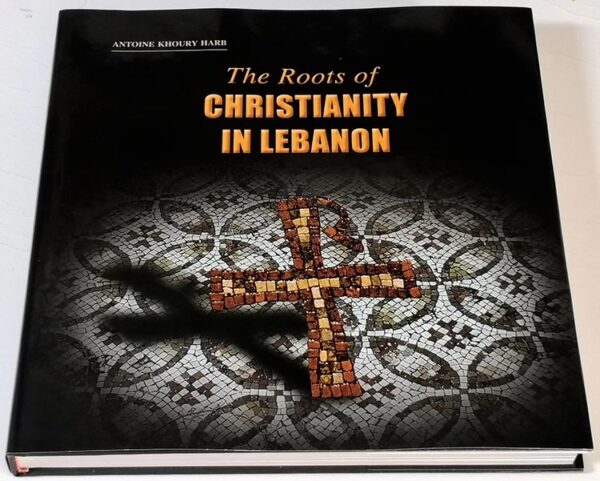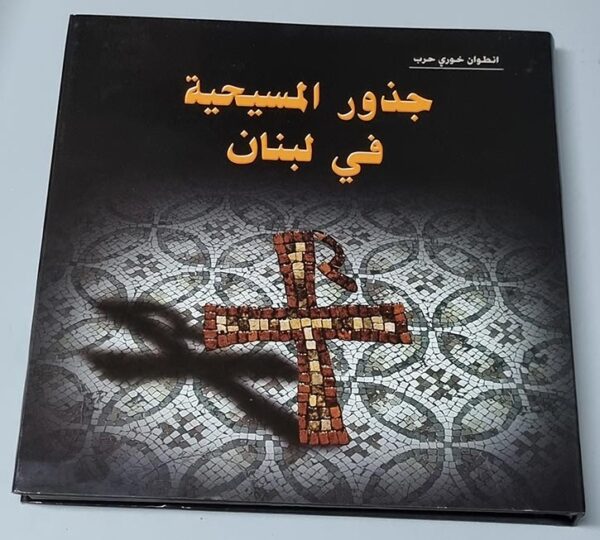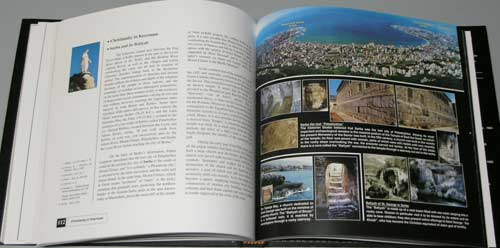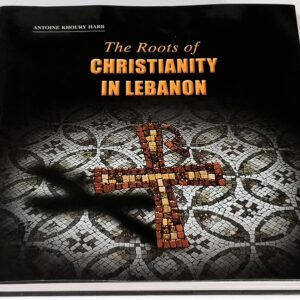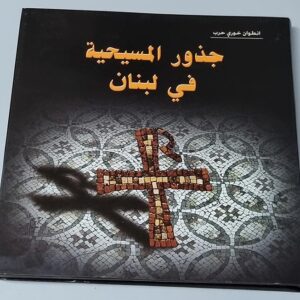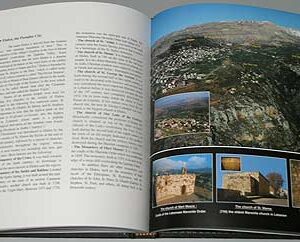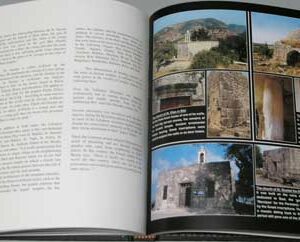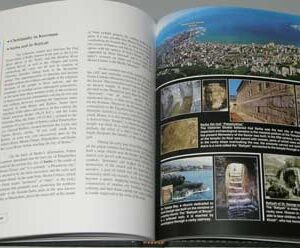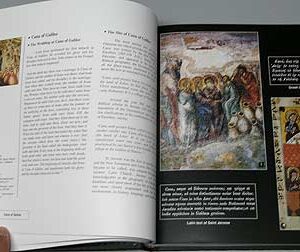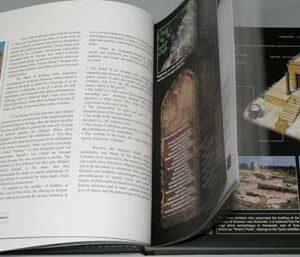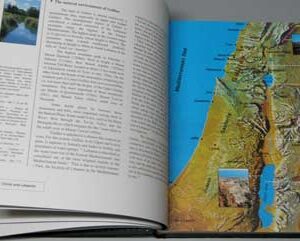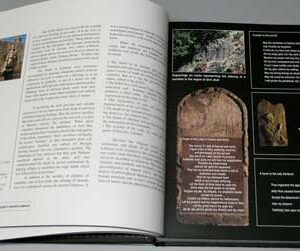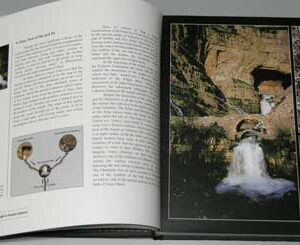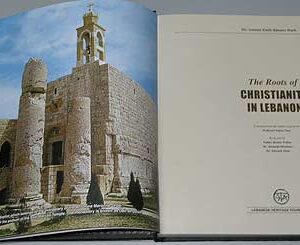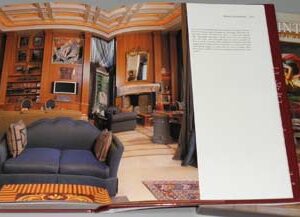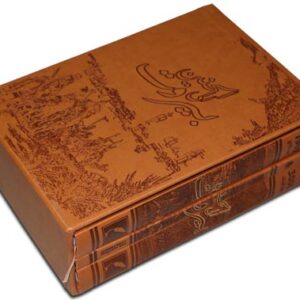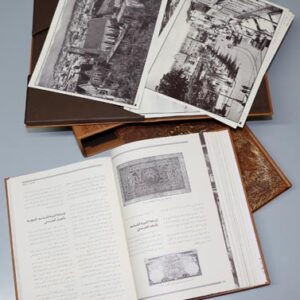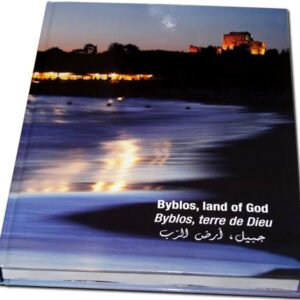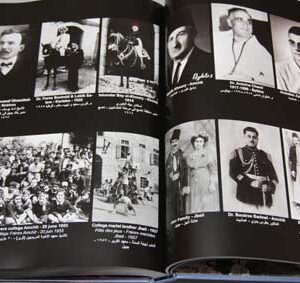The Roots of Christianity in Lebanon
Price range: $ 53.25 through $ 65.00
The Roots of Christianity in Lebanon by Dr. Antoine Emile Khoury Harb – Size: 29 x 29 x 2.6 cm, hardcover, 215 pages
- Description
- Shipping & Return
Description
The Roots of Christianity in Lebanon جذور المسيحية في لبنان by Dr. Antoine Emile Khoury Harb – Translated from the Arabic original by Professor Najwa Nasr
Reviewed by Father Boulos Wehbe, Mr. Kenneth Mortimer, Dr. Edward Alam – Lebanese Heritage Foundation.
Size: 29 x 29 x 2.6 cm, hardcover, 215 pages, weight 2kgs, 2008 – Available in Arabic as well.
Preface by H. E. Metropolitan George Khodr
“When you witness the unity of the archaeological remains of churches, shrines, and sanctuaries, you behold the pure Christianity residing in our past, and you trace the permanence of doctrinal unity in archaeological sites… Then, you come to the conviction that those roots have come down to earth from heaven, as though Christian Lebanon fell on us from on high, as though God viewed it as one of His places of residence on earth.”
The uniqueness of the author lies in the fact that he is at the same time an archaeologist and a historian. Both fields have different but complementary approaches. The past depends on knowledge of the stone and of written records.
Dr. Antoine Khoury Harb entitles his book The Roots of Christianity, but in fact, he goes far beyond these roots and addresses Lebanon’s ancient and modern history as well.
The beauty of this work lies in the illustrations of the archaeological vestiges which add to the content and deepen your comprehension of it. The sobriety of the work is based on the sources that document both the Greek and the Latin citations, which make you live the origins and agree with most of what is said. Dr. Harb does not leave out any place that Christianity has reached without leading you to it and its past, allowing you to live through it. He also puts you, through careful scrutiny, in contact with the flow of the ages. He attracts you to the ancestors who preached the Word of Christ in this land, and often uses the names of bishops or martyrs in their original script (Latin or Greek) for more precision and recognition.
You may disagree with him regarding certain details because he has based his argument on recent ideas, but the work remains highly academic in its entirety. The author does not neglect any sanctuary or village deeply rooted in antiquity; he carries out his research with objectivity independent of any specific Christian denomination. His sole concern is the site, not the contemporaries who use the place.
His main concern is to show that Jesus of Nazareth shed His light on Lebanon during His preaching. The author mentions that Jesus entered Tyre and Sidon, whereas the Bible only mentions Christ’s passage across their borders. Furthermore, the author strongly defends the hypothesis that “Cana of Galilee” is in fact “Cana of Tyre”, and supports plausibly his opinion with much evidence, although western scholars are still hesitant with respect to this thesis. Likewise, he allows a great deal of importance to the Phoenician Triad of Baal, Ishtar, and Adon as a Phoenician predisposition for the acceptance of the Christian Trinity, although the Phoenician Triad is one of gender while there is no trace of gender in the Christian Trinity.
Was there anything in Lebanon which paved the way for Christianity? Perhaps the legend of Adon who died and rose embodies features of Christ’s suffering and resurrection, with the major difference that Jesus existed and Adon did not. Was Plato in Greece a forerunner of Christ, or was he not? The Church expressed reservations with respect to certain Platonic teachings, though a minority of Church Fathers saw that his writings embodied seeds of the Christian doctrine. The whole issue is interpretation; what one views as cohesive, another finds incoherent.
The most important characteristic of this book is that Dr. Harb does not error as he meticulously analyzes the Christian heresies and the controversies of the ecumenical and local councils, even though he is no theologian. I have rarely found nonprofessional theologians who did not misrepresent theological issues. He knows the Orthodox, Jacobite and Nestorian points of view quite well. And although one notices much disparity between the approaches of those who teach doctrine and those who teach ecclesiastical history, one finds that Dr. Harb covers both fields accurately.
Even though the work is comprehensive and covers the whole area of Lebanon, there is more emphasis on the coastal areas and the regions of the North, as these are the cradle of Lebanese Christianity; furthermore, one always finds a link with the Antiochian Church of which the Church of Lebanon is a part. It is up to the reader to look for the distinguishing features of the different regions. Perhaps the feature that best unifies the various regions is the architectural style which the author makes ample use of because it embodies the spiritual culture of the faithful and expresses their penetration of the liturgical mystery, that is to say their knowledge of God’s radiance in Christ. How you pray, and what you say in your prayer, is an indication of the nature of your faith.
The fact that Byzantine architecture is predominant, as the archaeological remains show, indicates that Antioch and Constantinople were originally united in faith, although the Monophysite doctrine prevailed in the Antiochian sphere for quite a while until the Chalcedonian doctrine finally gained the upper-hand in the Lebanese sphere, a doctrine which most of the Lebanese Christian communities adhere to today. There was absolutely no difference among us during the Middle Ages. This makes me understand that the churches had the same Byzantine architectural design before Western Christianity spread in our region. Our ancestors in the Middle Ages unanimously agreed, in more than twelve documents, that the Orthodox, the Jacobites, and the Nestorians share the same faith, although they disagreed in the verbal expressions of their doctrine. This further consolidates the validity of the title The Roots of Christianity in Lebanon.
When you witness the unity of the archaeological remains of churches, shrines, and sanctuaries, you behold the pure Christianity residing in our past, and you trace the permanence of doctrinal unity in archaeological sites. Supporting these are the clear maps that guide you to the places you can visit, and thus you stroll in those ancient cities feeling as if you were one with those who built them. Only then, you come to the conviction that those roots have come down to earth from heaven, as though the Christian Lebanon fell on us from on high, as though God viewed it as one of His places of residence on earth.
Everyone who has studied the Byzantine civilization, crystallized in our hermitages, feels that he is one with its beauty and one in theological aspirations, and that Byzantium is the daughter of Antioch, not its mother. Antioch “faces” Lebanon, which suggests that they are intimately related. Thus, the author sustains that the Gospel as both message and record, first appeared in our country and its neighborhood.
I reveal no secret if I say that Antoine Khoury Harb, whose work I am now familiar with, is a living bearer of Christ. We are not companions of the dead. We are the product of a heritage, and Antoine Khoury Harb revives this heritage in this unique book. It is a book that leaves a deep impact on you if you come to grips with its content; and if you take pride in your predecessors, it makes you feel more attached to your homeland, and leads you to the Truth dwelling in you.
Metropolitan George Khodr
Broummana, 28 May 2007
Table of Contents:
– Dedication
– Table of contents
– Foreword by H.B. Nasrallah Boutros Cardinal Sfeir, Maronite Patriarch of Antioch and the Entire East
– Foreword by H.B. Ignatius Moussa Cardinal Daoud, Emeritus Patriarch of Antioch of the Syriacs
– Preface by H.E. Metropolitan George Khodr, Greek Orthodox Archbishop of Mount Lebanon
Introduction
Part One: Lebanon’s Predisposition to Christianity
1. Religious Thought in Ancient Lebanon
A- El, the Supreme God
B- Ashtarut, the Great Mother-Goddess
C- Adon, the Lord
D- Afqa, Seat of El
E- The Myth of Adon and Adonite Rituals
2. Philosophical Thought during the Hellenistic Period
Part Two: Christ and Lebanon
1. Galilee, Homeland of the “Galilean”
A- Natural Environment of Galilee
B- Ethnic Characteristics of the Galileans
C- Cultural Characteristics of Galilee
2. Christ’s Transfiguration on Mount Hermon
A- Hermon, the “Holy Mountain”
B- Hermon, Mount of the Transfiguration
3. Cana of Galilee
A- The Wedding at Cana
B- The Site of Cana
C- Archaeological Vestiges in Cana
D- The Shrine of “Prophet Imran” in Qolaileh
4. Christ in Tyre and Sidon Region
A- Healing of the Canaanite Woman’s Daughter
B- Jesus Christ in Sidon
. Sanctuary of “Lady of Mantara”
. Sarepta of Sidon (Sarafand)
Part Three: Christianity in Lebanon
1. Christianity in Tyre
A- Early Persecution of the Christians
B- Martyrs from Tyre C- Bishops of Tyre
. Participation in the Ecumenical Councils . Frumentius and the Evangelization of “Ethiopia”
2. Christianity in Sidon
A- Sidon, “First Born of Canaan”
B- Sidon, “City of Eshmun”
C- The Mithraic Rituals in Sidon
D- The Spread of Christianity in Sidon
E- Bishops from Sidon
3. Christianity in Jiyeh Region
A- The Bishopric of Jiyeh
B- The Shrine of Nebi Younes
C- Archaeological Vestiges of Shhim
. The Ancient Temple
. The Byzantine Church
4. Christianity in Beirut
A- Beirut, “star of Lebanon”
B- Did Christ visit Beirut?
C- Christianity in Beirut
. Bishops from Beirut
D- Beirut, “Mother of Laws”
E- Beirut, Center of Theological Studies
5. Christianity in Kesrouan Region
A- Sarba and its “Batiyah”
B- Byzantine Church of Ghineh
C- Faqra and its Byzantine Church
6. Christianity in Jbeil (Byblos) and its Region
A- Jbeil, the Holy Phoenician City
B- Christianity in Jbeil
C- Bishops of Jbeil after John Mark
D- Christianity in the Adon Land
. Saint Georges “Al-Khodr”
. The Ancient Churches
7. Christianity in the Batroun Region
A- Batroun, the Rock City
B- Christianity in Batroun and its Coast
C- Ancient Churches in Mid Batroun Region
D- Ancient Churches in the Upper Batroun Region
8. Christianity in Jibbet Bsharry Region
A- St. Simon the Stylite and the Christianization of Jibbet
B- Monasteries, Churches and Hermitages of Qannoubeen
C- Ehden, the “Paradise City”
. Mar Antonios Qozhaya
. Grotto of “Assi Al- Hadath”
9. Christianity in Koura Region
A- Anfe, “Stone Nose”
B- Amioun
C- Balamand Monastery
D- Grotto of Saint Marina (Qalamoun)
10. Christianity in Tripoli
A- Tripoli, the “Triple City”
B- Spread of Christianity in Tripoli
. Bishops from Tripoli
. Martyrs from Tripoli
11. Christianity in Akkar Region
A-Arqa, Ancient Metropolis of Akkar
B- Christianity in Akkar Mountains
. The Qobayyat Region
. Akroum, Mendgez, Wadi Khaled Regions
12. Christianity in Lebanese Beqaa
A- Baalbek, “City of Baal”
B- Christianity in Baalbek
C- Christianity in Ras Baalbek
D- Christianity in Hermel Region
E- Christianity in Deir el-Ahmar
. Beshwat
. Btid’ hi
. Shleefa
. Yammouneh
F- Nabha and its Church
G- Christianity in the Mid Beqaa Regions
. Furzol
. Hosn Niha
H- Christianity in the South Beqaa Region
. Anjar
. Dakweh
. Manara
Conclusion
Acknowledgments
Bibliography
Index of Geographical Names
Index of Person Names
a. View or Modify What is in Your Shopping Cart.
When in the Shopping Cart area of the site you can view or modify what is in your shopping cart at any time by clicking on the Add More Items/Refresh Totals button along the bottom of your screen.
b. Checking Out and pay for your purchases online.
When you have finished viewing and wish to end your shopping and pay for the items you have selected, click on the Pay & Finish button at the bottom of your screen.
You will be led through a series of secure ordering procedures and will be asked to fill in personal, shipping and payment option information. When this is completed, you will press the Submit Secure Checkout button and your order will be transmitted to LebanonPostcard for fulfillment.
Absolutely not! Right up until the point why you are asked to review the order information you have given us and if it is correct to click on the final Submit Secure Order button, you can abort the order.
If you don't press the Submit Secure Order button then no order information is transmitted to us.
a. Payment by Credit Card
We accept American Express, MasterCard, Visa, Discover, PayPal... etc... for online payments through 2CheckOut.com. Also, arrangements can be made for bank draft and certified check payments by regular post.
b. Payment by Bank Draft and Certified Check
If you would prefer to pay for your purchases by mail, then you have to contact us first so we can give you our account information.
c. We accept as well payment through WesternUnion, RIA, OMT, BOB Finance, Whish Money.
All prices include shipping and handling. LebanonPostcard will be responsible for sending the packages you order, at your charge, through the service D.H.L. / E.M.S. with tracking number code guaranteeing reception of the package.
We ship as soon as possible, but within maximum 4 days after the order is received.
Credit cards are not charged until we actually ship the items. The items may take between one and six days to arrive, according to the country they are sent to.
Packages are sent with track code to guarantee reception, and delay is rare. In the event of non-delivery or delay, nothing can be done for 7 days. At the end of this period, on our being informed, a demand will be made for the package to be traced. If 14 days after the first dispatch there is still no delivery, a second package will be sent free.
Packages inside Lebanon are sent registered through LibanPost to guarantee reception, and delay or non-delivery is rare. In the event of non-delivery, nothing can be done for 6 days. At the end of this period, on our being informed, a demand will be made to LibanPost for the package to be traced. If 12 days after the first dispatch there is still no delivery, a second package will be sent free.
We ship anywhere in the world. Zones and countries we ship to
Yes. You can cancel you order when you receive an email from us confirming your order, you can reply by canceling it.

